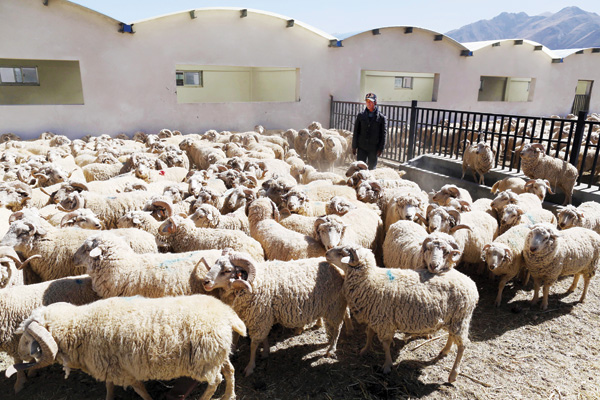Hybrid sheep boost farmers' incomes
Updated: 2015-06-05 12:12
By Palden Nyima in Lhundrub County, Tibet(China Daily USA)
|
||||||||
 |
|
Gyatso, a 38-year-old farmer from Jangshar, Lhundrub county, said his income has doubled since he started to keep Phanpo sheep six years ago. Zhu Xingxin / China Daily |
With its curled horns and thick coat, the Phanpo sheep stands out from the small, plump, thick-horned varieties that usually populate the grasslands of the Tibetan plateau.
The farmers who raise them in Lhundrub county can also be told apart by the size of their smiles.
The Phanpo sheep, known for its quality semi-fine wool and meat, is a hybrid of varieties native to Russia, and China's Inner Mongolia and Tibet autonomous regions.
Work to create the species started in the 1960s, and in 2008 the National Commission of Livestock and Poultry Genetic Resources officially acknowledged it as Tibet's first stain of livestock.
"More rural Tibetans have started been keep Phanpo sheep as a way to boost their income since 1998," said Buchung, a veterinarian in Jangshar township. He explained that the breed is more economic than the traditional Tibetan sheep.
"The wool yield is six times that of a Tibetan sheep, and the production of meat is double," said the 53-year-old, who has kept Phanpo sheep for more than six years and now has a flock of 280.
"I'm a direct beneficiary of the fruit of scientific and technological research," he said. "My average annual income has been 80,000 yuan ($13,000) in recent years."
About 650 households in the county each raise more than 200 head of sheep, according to local estimates.
Gyatso, 38, another Jangshar farmer, has kept Phanpo sheep for more than six years. He said: "My family has more than 200 head, and my average annual income has doubled since I got them."
Yontan, director of the country science and technology bureau and head of the local animal husbandry and veterinary station, said he led a research team for 48 years to develop the new breed. The results have earned him many accolades and awards.
"The fineness of the semi-fine wool (from Phanpo) is usually between 58 and 60 microns, and it is used best for cashmere products," the 61-year-old said, adding that Tibetans have welcomed the thicker wool and now use it to make quilts, blankets and other products.
He said the regional government has been promoting the breed in other prefectures in an effort to boost farmers' incomes and has been offering families a subsidy of 800 yuan.
"The demand for wool is huge in Tibet, as most Tibetans make nambu, a heavy woolen cloth," said Tsering Choedron, a Tibetan tailor. "A nambu needs 15 kilograms of wool. To make one takes just six Phanpo sheep, or alternatively 30 Tibetan sheep."
- Crews raise capsized ship to assist search
- China rescuers right ship to speed up search for missing
- More countries send condolences over China's cruise ship accident
- Test centers set stage for smooth gaokao
- 14 cities to draw red line to stop urban sprawl
- Personal items of sunken ship passengers found

 Operation underway to turn the ship over
Operation underway to turn the ship over
 Prayers held for ship passengers
Prayers held for ship passengers Warriors beat Cavs in Game One OT thriller
Warriors beat Cavs in Game One OT thriller
 Cannavaro's Evergrande life in photos
Cannavaro's Evergrande life in photos
 Ten photos you don't wanna miss - June 5
Ten photos you don't wanna miss - June 5
 Chicago gets a present from Shanghai
Chicago gets a present from Shanghai
 Rescuers cut into capsized ship in search for survivors
Rescuers cut into capsized ship in search for survivors
 Search-and-rescue operation enters third day
Search-and-rescue operation enters third day
Most Viewed
Editor's Picks

|

|

|

|

|

|
Today's Top News
Startups return to China to battle pollution
Rescuers right ship to speed up recovery
Overseas real estate investment hits record $7.5b in Q1
Editorial: Aquino shows a lack of sense or sensibility
60% of Chinese youth OK with premarital sex: survey
65 bodies found, more than 370 still missing
Ex-FIFA executive detailed bribes in 2013 secret guilty plea
HK economy will suffer if reform fails, tycoon says
US Weekly

|

|







